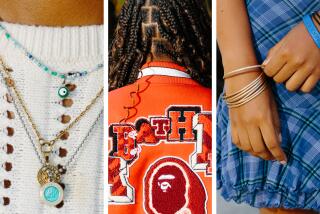Commentary : Uniforms Aid Student Performance : Academics: Not only do uniforms eliminate status wars, they help students concentrate on schoolwork.
- Share via
All of these people understand something that is very basic and logical: that if you own this child at an early age, you can own this child for years to come. . . . Companies are saying, ‘Hey, I want to own the kid younger and younger and younger.’ ” --Mike Searles, president of Kids ‘R’ Us
With about 4,000 days of the 20th Century remaining, we have come face to face with the truth of at least one old adage--”Clothes make the man,” or, in less chauvinistic language more in tune with the economics of the children’s clothing market, “Clothes (with proper advertising budgets and correct market positioning) make (so long as we can convince them through media and pressure) the child.”
To extend the logic, the child who is “made” is certain to be more accepted, more popular and, socio-economically at least, perceived to be better off. It’s a simplistic logic that preys on precisely those fears that mark adolescent life. It should sadden us greatly that this economic victimization of children is occurring. It should shock us more that at least some parents fall prey to the same temptation--believing, I suppose, that brand-name status somehow equates with successful parenting.
I wonder at times when we can expect the list of popular first names of children to expand so that Reebok, Bugle Boy, Jordache and Esprit will rank right up there with Michael, Monica, Annie and James.
But there is something we can do to lessen the influence of Madison Avenue.
Parents can claim their proper role as parents and demand of their schools--public and private--that children adhere to a strict dress code. This would create at least one environment in which what one wears is secondary to what one learns--an elementary principle that this elementary principal has found contributes to academic and developmental success.
Simply put, children should be in uniform when they go to school.
When critical thinking skills are used to determine what label is being worn by the student in the next row, legitimate education is impaired. When recess and lunch discussion center on itemized analysis of what the “in” group is wearing, student focus is distorted. By removing the clothing distraction, parents can ensure that at least one non-educational element is removed from the thinking process.
Uniforms also save money. At Blessed Sacrament elementary school in East San Diego, one child’s uniforms--skirts or jumpers and blouse for girls and slacks and shirts for boys--will generally not exceed $100 per year--even if parents choose to purchase the non-mandatory accessories. I shudder at the financial burden that families in non-uniform schools must endure, and, as the father of two girls, I secretly rejoice in July and August when I can walk by the many back-to-school “sales.”
In an age of competing economic ability, children from lower-income homes, and even middle-income homes, would be at least sartorially equal in the minds of their fellow students if all wore uniforms. The promotion of values based on a positive self-concept and rooted in the premise that all children do have an opportunity to be equal would serve any school well.
Uniforms would also help eliminate the “color conspiracy” in neighborhoods with gang activity. There would be fewer school assaults based on gang clothing identification and less psychological intimidation.
But the main reason for uniforms is that they promote discipline, which in turn helps improve academic performance.
Blessed Sacrament eliminated uniforms for a while in the 1970s, but returned to them at the parents’ strong request. Now students have a free-dress policy that allows the student council to set the dress code one day a month. The uniform policy is reviewed every year by the parent-teacher group, and, predictably, each year the student council asks for a free-dress policy.
But our teachers have found that discipline is better on days when students are wearing uniforms. On free-dress days, students are less attentive, they talk more in class, and they are more boisterous--not because of some new-found freedom from the assumed restrictions on self-expression that uniform-wearing schools are frequently accused of, but rather because there is a less serious attitude in the classroom.
In conversation with students from our school, the amount of time they spend trying to decide what to wear on free-dress days comes up frequently as a topic of stress. Their parents make the same comment--and they say the amount of time a child takes deciding what to wear increases geometrically with age. Would that all of that time could be spent buying back a few precious moments of the family intimacy that 20th-Century America makes so impossible.
Blessed Sacrament is the largest Catholic elementary school in the city of San Diego, with 418 students in preschool through the ninth grade. It’s an urban campus where 30% of the students come from single-parent homes, and, in 93% of the families, the single parent or both parents work outside the home. Forty percent of the students are from other than Anglo ethnic groups. And 25% of our students come from families poor enough to qualify for free or reduced-price school lunches.
It’s a socioeconomic makeup in which academic standards can often be hard to meet. Yet at Blessed Sacrament, standardized test scores are 30 to 40 points above the national average.
I would be the first to admit that the presence of the uniform policy is not the only secret of our students’ success, but without uniforms I believe they would not perform as well academically.
Oh--as to Mr. Searles: You don’t “own” my children.
More to Read
Sign up for Essential California
The most important California stories and recommendations in your inbox every morning.
You may occasionally receive promotional content from the Los Angeles Times.














